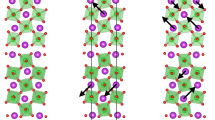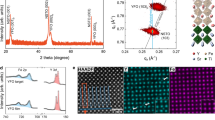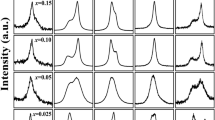Abstract
We describe the first-principles design and subsequent synthesis of a new material with the specific functionalities required for a solid-state-based search for the permanent electric dipole moment of the electron. We show computationally that perovskite-structure europium barium titanate should exhibit the required large and pressure-dependent ferroelectric polarization, local magnetic moments and absence of magnetic ordering at liquid-helium temperature. Subsequent synthesis and characterization of Eu0.5Ba0.5TiO3 ceramics confirm the predicted desirable properties.
This is a preview of subscription content, access via your institution
Access options
Subscribe to this journal
Receive 12 print issues and online access
$259.00 per year
only $21.58 per issue
Buy this article
- Purchase on Springer Link
- Instant access to full article PDF
Prices may be subject to local taxes which are calculated during checkout





Similar content being viewed by others
References
Trodden, M. Electroweak baryogenesis. Rev. Mod. Phys. 71, 1463–1500 (1999).
Khriplovich, I. B. & Lamoreaux, S. K. CP Violation Without Strangeness (Springer, 1997).
Bernreuther, W. & Suzuki, M. The electric dipole moment of the electron. Rev. Mod. Phys. 63, 313–340 (1991).
Hudson, J. J., Sauer, B. E., Tarbutt, M. R. & Hinds, E. A. Measurement of the electron electric dipole moment using YbF molecules. Phys. Rev. Lett. 89, 023003 (2002).
Kawall, D., Bay, F., Bickman, S., Jiang, Y. & DeMille, D. Precision Zeeman–Stark spectroscopy of the metastable a(1)[ 3σ+] state of PbO. Phys. Rev. Lett. 92, 133007 (2004).
Griffith, W. C. et al. Improved limit on the permanent electric dipole moment of 199Hg. Phys. Rev. Lett. 102, 101601 (2009).
Guest, J. R. et al. Laser trapping of 225Ra and 226Ra with repumping by room-temperature blackbody radiation. Phys. Rev. Lett. 98, 093001 (2007).
Tardiff, E. R. et al. Polarization and relaxation of 209Rn. Nucl. Instrum. Methods Phys. Res. A 579, 472–475 (2007).
Stutz, R. P. & Cornell, E. A. Search for the electron EDM using trapped molecular ions. Bull. Am. Phys. Soc. DAMOP04, J1.047 (2004).
Weiss, D. S., Fang, F. & Chen, J. Measuring the electric dipole moment of Cs and Rb in an optical lattice. Bull. Am. Phys. Soc. APR03, J1.008 (2003).
Baker, C. A. et al. Improved experimental limit on the electric dipole moment of the neutron. Phys. Rev. Lett. 97, 131801 (2006).
Ledbetter, M. P., Savukov, I. M. & Romalis, M. V. Nonlinear amplification of small spin precession using long-range dipolar interactions. Phys. Rev. Lett. 94, 060801 (2005).
Heidenreich, B. J. et al. Limit on the electron electric dipole moment in gadolinium–iron garnet. Phys. Rev. Lett. 95, 253004 (2005).
Bouchard, L. S., Sushkov, A. O., Budker, D., Ford, J. J. & Lipton, A. S. Nuclear-spin relaxation of 207Pb in ferroelectric powders. Phys. Rev. A 77, 022102 (2008).
Shapiro, F. L. Electric dipole moments of elementary particles. Sov. Phys. Usp. 11, 345–352 (1968).
Lamoreaux, S. K. Solid-state systems for the electron electric dipole moment and other fundamental measurements. Phys. Rev. A 66, 022109 (2002).
Budker, D., Lamoreaux, S. K., Sushkov, A. O. & Sushkov, O. P. Sensitivity of condensed-matter P- and T-violation experiments. Phys. Rev. A 73, 022107 (2006).
Sushkov, A. O., Eckel, S. & Lamoreaux, S. K. Prospects for a new search for the electron electric-dipole moment in solid gadolinium–iron-garnet ceramics. Phys. Rev. A 79, 022118–8 (2009).
Sushkov, A. O., Eckel, S. & Lamoreaux, S. K. The prospects for an electron electric dipole moment search with ferroelectric (Eu,Ba)TiO3 ceramics. Phys. Rev. A 81, 022104 (2010).
Spaldin, N. A. & Ramesh, R. Electric-field control of magnetism in complex oxide thin films. MRS Bull. 33, 1047–1050 (2008).
Fiebig, M. Revival of the magnetoelectric effect. J. Phys. D 38, R1–R30 (2005).
Mukhamedjanov, T. N., Dzuba, V. A. & Sushkov, O. P. Enhancement of the electron electric dipole moment in gadolinium garnets. Phys. Rev. A 68, 042103 (2003).
Hill, N. A. Why are there so few magnetic ferroelectrics? J. Phys. Chem. B 104, 6694–6709 (2000).
Merz, W. J. The dielectric properties of BaTiO3 at low temperatures. Phys. Rev. 81, 1064–1065 (1951).
Rondinelli, J. M., Eidelson, A. S. & Spaldin, N. A. Non-d0 Mn-driven ferroelectricity in antiferromagnetic BaMnO3 . Phys. Rev. B 79, 205119 (2009).
Ramesh, R. & Spaldin, N. A. Multiferroics: Progress and prospects in thin films. Nature Mater. 6, 21–29 (2007).
Wemple, S. Jr & Camlibel, M. D. Dielectric and optical properties of melt-grown BaTiO3 . J. Phys. Chem. Solids 29, 1797–1803 (1968).
Miyake, S. & Ueda, R. On phase transformation of BaTiO3 . J. Phys. Soc. Jpn 2, 93–97 (1947).
Katsufuji, T. & Takagi, H. Coupling between magnetism and dielectric properties in quantum paraelectric EuTiO3 . Phys. Rev. B 64, 054415 (2001).
Kamba, S. et al. Magnetodielectric effect and optic soft mode behaviour in quantum paraelectric EuTiO3 ceramics. Europhys. Lett. 80, 27002 (2007).
Fennie, C. J. & Rabe, K. M. Magnetic and electric phase control in epitaxial EuTiO3 from first principles. Phys. Rev. Lett. 97, 267602 (2006).
McGuire, T. R., Shafer, M. W., Joenk, R. J., Alperin, H. A. & Pickart, S. J. Magnetic structure of EuTiO3 . J. Appl. Phys. 37, 981–982 (1966).
Chien, C-L., DeBenedetti, S. & Barros, F. D. S. Magnetic properties of EuTiO3, Eu2TiO4, and Eu3Ti2O7 . Phys. Rev. B 10, 3913–3922 (1974).
Shvartsman, V. V., Borisov, P., Kleemann, W., Kamba, S. & Katsufuji, T. Large off-diagonal magnetoelectric coupling in the quantum paraelectric antiferromagnet EuTiO3 . Phys. Rev. B 81, 064426 (2010).
Goian, V. et al. Polar phonon mixing in magnetoelectric EuTiO3 . Eur. Phys. J. B 71, 429–433 (2009).
Janes, D. L., Bodnar, R. E. & Taylor, A. L. Europium barium titanate—a magnetic ferroelectric compound. J. Appl. Phys. 49, 1452–1454 (1978).
Hlinka, J. et al. Coexistence of the phonon and relaxation soft mode in the terahertz dielectric response of tetragonal BaTiO3 . Phys. Rev. Lett. 101, 167402 (2008).
Perdew, J. P., Burke, K. & Ernzerhof, M. Generalized gradient approximation made simple. Phys. Rev. Lett. 77, 3865–3868 (1996).
Anisimov, V. I., Aryasetiawan, F. & Liechtenstein, A. I. First-principles calculations of the electronic structure and spectra of strongly correlated systems: The LDA+U method. J. Phys. Condens. Matter 9, 767–808 (1997).
Dudarev, S. L., Botton, G. A., Savrasov, S. Y., Humphreys, C. J. & Sutton, A. P. Electron-energy-loss spectra and the structural stability of nickel oxide: An LSDA+U study. Phys. Rev. B 57, 1505–1509 (1998).
Kresse, G. & Furthmüller, J. Efficient iterative schemes for ab initio total-energy calculations using a plane-wave basis set. Phys. Rev. B 54, 11169–11186 (1996).
Blöchl, P. E. Projector augmented-wave method. Phys. Rev. B 50, 17953–17979 (1994).
King-Smith, R. D. & Vanderbilt, D. Theory of polarization of crystalline solids. Phys. Rev. B 47, 1651–1654 (1993).
Kunc, K. & Martin, R. M. Ab initio force constants of GaAs: A new approach to calculation of phonons and dielectric properties. Phys. Rev. Lett. 48, 406–409 (1982).
Alfe, D. PHON: A program to calculate phonons using the small displacement method. Comp. Phys. Comm. 180, 2622–2633 (2009).
Acknowledgements
This work was supported by the US National Science Foundation under award number DMR-0940420 (NAS), by Yale University, by the Czech Science Foundation (project Nos. 202/09/0682 and AVOZ10100520) and by the Young Investigators Group Programme of the Helmholtz Association, Germany, contract VH-NG-409. We thank O. Pacherova, R. Krupkova and G. Urbanova for technical assistance and O. Sushkov for discussions.
Author information
Authors and Affiliations
Contributions
S.K.L. supervised the EDM measurement effort at Yale. A.O.S. and S.E. carried out the analysis and made preliminary measurements, showing that these materials could be useful in an EDM experiment. M.L. and N.A.S. selected (Eu,Ba)TiO3 as the candidate material according to the experimental requirements and supervised the ab initio calculations. K.Z.R. carried out the ab initio calculations. M.L., N.A.S. and K.Z.R. analysed the ab initio results and wrote the theoretical component of the paper. Ceramics were prepared by P.V. Crystal structure was determined by K.K. and F.L. Dielectric measurements were carried out by M.S. J.P. investigated magnetic properties of ceramics. V.G. carried out infrared reflectivity studies. D.N. investigated terahertz spectra. S.K. coordinated all experimental studies and wrote the synthesis and characterization part of the manuscript. N.A.S. coordinated the preparation of the manuscript.
Corresponding author
Ethics declarations
Competing interests
The authors declare no competing financial interests.
Rights and permissions
About this article
Cite this article
Rushchanskii, K., Kamba, S., Goian, V. et al. A multiferroic material to search for the permanent electric dipole moment of the electron. Nature Mater 9, 649–654 (2010). https://doi.org/10.1038/nmat2799
Received:
Accepted:
Published:
Issue Date:
DOI: https://doi.org/10.1038/nmat2799
This article is cited by
-
Spintronics and Innovative Memory Devices: a Review on Advances in Magnetoelectric BiFeO3
Journal of Superconductivity and Novel Magnetism (2021)
-
Advances in magnetoelectric multiferroics
Nature Materials (2019)
-
Multiferroic quantum criticality
Nature Materials (2019)
-
Comprehension of the Electric Polarization as a Function of Low Temperature
Journal of Low Temperature Physics (2017)
-
Structure, Ferromagnetic, Dielectric and Electronic Features of the \(\hbox {LaBiFe}_{2}\hbox {O}_{6}\) LaBiFe 2 O 6 Material
Journal of Low Temperature Physics (2017)



